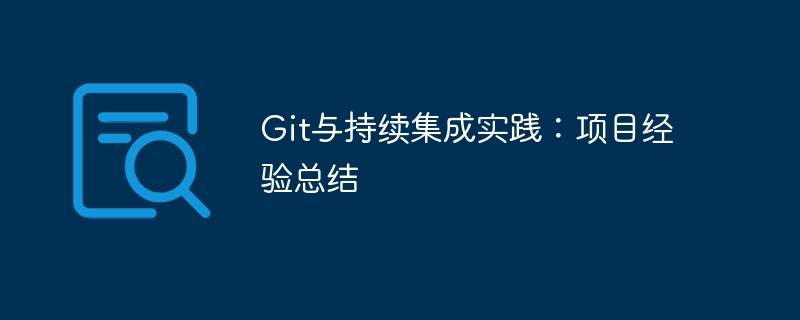
Git and continuous integration practice: project experience summary
Introduction:
In the field of software development, version control and continuous integration are two very important concepts. Git, as a distributed version control system, is widely used in project development. Continuous integration can improve team collaboration efficiency and software delivery quality. This article will summarize my experience using Git and continuous integration practices in projects.
1. Git usage experience:
- Code branch management:
In project development, Git branch management is very important. We usually use the master branch as the basis for stable versions, while developers develop features on the feature branch. When merging code, we use the pull request mechanism to allow other developers to review the code to ensure code quality.
- Team collaboration:
Git's collaboration function allows team members to easily share and merge code. By creating shared branches on remote repositories, team members can update and commit code in real time. At the same time, using Git's conflict resolution tool can help team members quickly resolve merge conflicts.
- Version control:
Git can record every modification of the code, making it easier for team members to trace code changes. Through Git's version control function, we can easily switch to a specific version and quickly find and modify bugs. At the same time, you can use the git stash command to temporarily store the current modifications to facilitate switching on different branches.
2. Practical experience of continuous integration:
- Automated construction:
The core of continuous integration is automated construction. We use Jenkins as a continuous integration tool to automatically trigger the build process after each code submission. Through Jenkins plug-ins and scripts, we can perform a series of automated operations such as compilation, testing, and deployment, which greatly improves development efficiency.
- Automated testing:
Continuous integration not only includes automatic construction of code, but also requires testing. We write unit tests and integration tests to ensure the stability of the code in different environments. At the same time, we also used code coverage tools to detect test coverage and further improve test quality.
- Code quality monitoring:
In order to ensure code quality, we use the SonarQube tool to statically analyze the code. SonarQube is able to detect potential problems and bad smells in the code and provide corresponding optimization suggestions. Through code quality monitoring during the continuous integration process, we can discover and fix problems in the code in a timely manner.
- Create reports and notifications:
Continuous integration also requires generating build reports and notifying team members. We use the Jenkins email plug-in to send build results and test reports to relevant personnel via email. At the same time, we also use instant messaging tools such as Slack in the project to notify team members of the build and test results in real time through integrated plug-ins.
Conclusion:
Git and continuous integration play a very important role in project development. Through the reasonable use of Git for code management and team collaboration, as well as perfect continuous integration practices, we can improve the efficiency and quality of software development and better meet project needs. I hope that the experience summary in this article can inspire readers' Git and continuous integration practices in project development.
The above is the detailed content of Git and continuous integration practice: summary of project experience. For more information, please follow other related articles on the PHP Chinese website!






